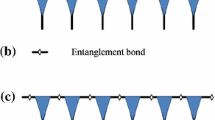Abstract
The uniform two-dimensional tensor network of the partition function is interpreted as a multiple product of the one-dimensional quantum Hamiltonian, which is the one-dimensional transfer operator. We perform infinite density matrix renormalization group with matrix product operator and matrix product state in the actual contraction of the two-dimensional tensor network. In the process of contraction, we focus on the half-chain entanglement entropy of the one-dimensional quantum state linked to the one-dimensional transfer operator. We show that the entanglement entropy correctly exhibits a singularity at the critical temperature in the Ising model. We note that when we try to determine the critical temperature, the entanglement entropy can do more precisely than the magnetization order parameter. The difference between our numerical result and the analytical value of the critical temperature is given by 0.00003. For complex models inaccessible to analytical techniques, our method using the entanglement entropy is suitable as long as the partition function is written as a tensor network.






Similar content being viewed by others
References
R. Orus, Ann. Phys. 349, 117 (2014)
S.R. White, Phys. Rev. Lett. 69, 2863 (1992)
S. Östlund, S. Rommer, Phys. Rev. Lett. 75, 3537 (1995)
U. Schollwöck, Annals Phys. 326, 96 (2011)
I. P. McCulloch, e-print arXiv:0804.2509 (2008)
M.H. Chung, J. Korean Phys. Soc. 78, 700 (2021)
M.H. Chung, E. Orignac, D. Poilblanc, S. Capponi, Phys. B 604, 412665 (2021)
J. Eisert, M. Cramer, M.B. Plenio, Rev. Mod. Phys. 82, 277 (2010)
G. Vidal, J.I. Lattorre, E. Rico, A. Kitaev, Phys. Rev. Lett. 90, 227902 (2003)
G. Vidal, Phys. Rev. Lett. 91, 147902 (2003)
M.C. Cha, M.H. Chung, Phys. B 536, 701 (2018)
T. Nishino, K. Okunishi, J. Phys. Soc. Jpn. 67, 3066 (1998)
M.T. Fishman, L. Vanderstraeten, V. Zauner-Stauber, J. Haegeman, F. Verstraete, Phys. Rev. B 98, 235148 (2018)
M.H. Chung, J. Korean Phys. Soc. 82, 776 (2023)
C.N. Yang, Phys. Rev. 85, 809 (1952)
F.F. Song, G.M. Zhang, Phys. Rev. B 105, 134516 (2022)
L. Onsager, Phys. Rev. 65, 117 (1944)
Acknowledgements
This work was partially supported by the Basic Science Research Program through the National Research Foundation of Korea (NRF) funded by the Ministry of Education, Science and Technology (Grant No. NRF-2021R1F1A1052347). The author would like to thank D. Poilblanc for helpful discussions.
Author information
Authors and Affiliations
Corresponding author
Additional information
Publisher's Note
Springer Nature remains neutral with regard to jurisdictional claims in published maps and institutional affiliations.
Rights and permissions
Springer Nature or its licensor (e.g. a society or other partner) holds exclusive rights to this article under a publishing agreement with the author(s) or other rightsholder(s); author self-archiving of the accepted manuscript version of this article is solely governed by the terms of such publishing agreement and applicable law.
About this article
Cite this article
Chung, MH. Entanglement entropy as a marker of phase transition in the Ising model. J. Korean Phys. Soc. 84, 356–361 (2024). https://doi.org/10.1007/s40042-023-01003-5
Received:
Revised:
Accepted:
Published:
Issue Date:
DOI: https://doi.org/10.1007/s40042-023-01003-5



